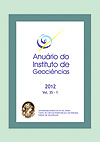Flooding hazard and risk mapping at Aparecida City (São Paulo)
DOI:
https://doi.org/10.11137/2012_2_28_42Abstract
Between 2001 e 2011, flooding affected 235 municipalities in the State of São Paulo (SE Brazil), including 29 municipalities situated in the Paraiba do Sul River Watershed (Eastern part of State). This paper presents a flooding hazard and risk mapping carried out in the City of Aparecida, including other related phenomena such as flash flooding, ponding, and river bank erosion. The investigation has explored the use of remote sensing tools and geospatial technologies in order to derive numerical scores for assessment and management of risk situations as well as regional and urban planning needs. Hazard analysis aimed at determining the probability of occurrence of flooding events, their spatial distribution, and estimated flooding heights. The main steps were the following: a) preliminary survey of previous occurrences based on information derived from newspapers and compilation of a geo-referenced database; b) delimitation and characterisation of flooding hazard zones, which explored image interpretation in combination with topographic maps and spatial data analysis (flooding heights - Nat - in particular); d) land use analysis that aimed at numerically estimating vulnerability and potential damage to different elements (people, property, economic activities); e) risk map including classification of risk zones using a numerical score (Rjn). A total of 41 flooding hazard zones and 62 risk zones were identified and delimited (6 zones of very high risk, 11 of high risk, 16 of moderate risk, and 29 of low risk).Downloads
Download data is not yet available.
Downloads
Published
2012-12-01
How to Cite
Andrade, E. de, Danna, L. C. and Silva, P. C. F. da (2012) “Flooding hazard and risk mapping at Aparecida City (São Paulo)”, Anuário do Instituto de Geociências. Rio de Janeiro, BR, 35(2), pp. 28–42. doi: 10.11137/2012_2_28_42.
Issue
Section
não definida
License
This journal is licensed under a Creative Commons — Attribution 4.0 International — CC BY 4.0, which permits use, distribution and reproduction in any medium, provided the original work is properly cited.















